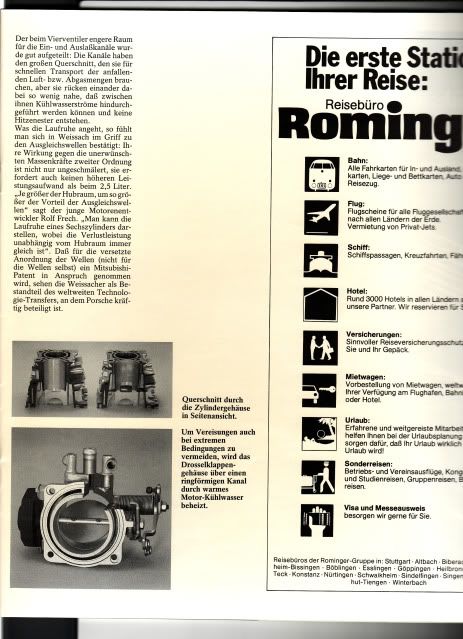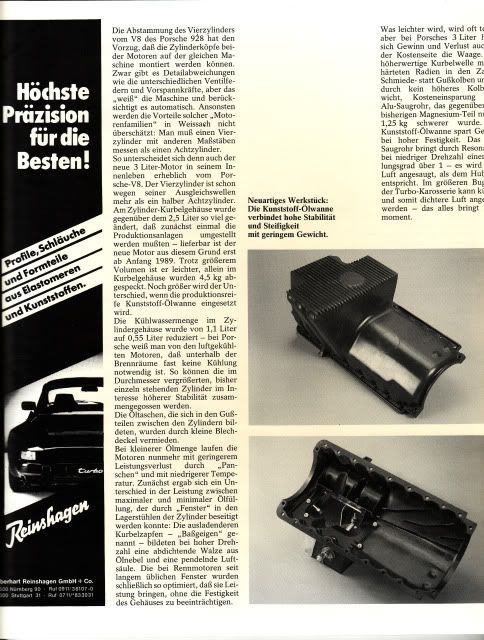when porsche went from 2.5 liters to 3.0 liters...
#1
Racer
Thread Starter
...what did they do to the engine in regards to increasing the displacement and what would the difference be in taking a 2.5 up to 3.0? i know they swapped the crank and imagine there was some bore/stroke work done, but what's the difference in what the factory did and what someone building an engine would do? i ask because i know a lot of people do engine swaps to go up in displacement, but it seems not a lot of people take the 2.5 block and go up to 3, just the usual 2.7 or 2.8. i'm going to be purchasing another 951 soon and would like to have a 3 liter in it. there's one i've found with the 3 liter swap, but i might not be back home and available to check it out before it sells. i don't have much patience either, so if i pick up the normal 2.5, i'm going to go crazy looking for a 3 liter block and waiting for all the work to be done and might just keep the engine in the car and do a 2.8 conversion, though i'd like the extra .2 liters. i have the money to do pretty much anything i want with the car, but i'm just too antsy when it comes to getting it back on the road!
#2
Addict
Rennlist Member
Rennlist Member
Join Date: May 2002
Location: Phoenix, AZ - NJ Runaway
Posts: 3,649
Likes: 0
Received 0 Likes
on
0 Posts
Going to 3.0L (off the top of my head at work) Porsche increased stroke & bore, notched bottom end for stroke clearance, siamesed bores, shortened water jacket, larger impeller WP, piston/pin/ring changes, added piston squirters (in 968), and I'm sure I'm missing a few things.
#3
Racer
Thread Starter
thank you. so is there any difference in reliability between the factory 3.0 and someone doing those same things (aside from the fact that we're not porsche engineers and can't do everything the way the factory did it)? i ask because time-wise, it seems easier to increase the displacement of the 2.5 to the 3.0 because that's the motor already in the car, rather than hunting down a 3.0 liter short block. so is the reasoning behind the 3.0 swap just the fact that a 3.0 block is out there and available? i also know that some people don't care for/trust boring and stroking the 2.5 or the sleeving process because of the material the block is made of. i would prefer to do the 3.0 liter swap anyway, but i'm not entirely sure why people don't start with the 2.5 and increase the displacement (looking at the 3.0 liter registry, most people start with the 3.0 liter short block).
#4
Race Car
Yeah, this isn't a small block Chevy. You can't just bore the thing out by 4mm. That is enormous. If you want that much more bore, you are going to sleeve the block, and at that point, it is probably cheaper and easier to find a 3.0L block. Then you need the crank, pistons, rods, etc.
The 3.0L block has some added windows to improve windage. It also is, for whatever reason, less prone to the dreaded #2 con rod failure.
The 3.0L block has some added windows to improve windage. It also is, for whatever reason, less prone to the dreaded #2 con rod failure.
#6
Rennlist Member
Join Date: Sep 2010
Location: Northern New Mexico
Posts: 61
Likes: 0
Received 0 Likes
on
0 Posts
This sums it up pretty well:
http://www.europeancarweb.com/lookba.../photo_03.html
the 3 liter block is apparently lighter and stiffer, and comes with forged pistons.
http://www.europeancarweb.com/lookba.../photo_03.html
the 3 liter block is apparently lighter and stiffer, and comes with forged pistons.
#7
but i'm not entirely sure why people don't start with the 2.5 and increase the displacement (looking at the 3.0 liter registry, most people start with the 3.0 liter short block).
Check out Porsche Christophorus magazine November 1988 story's pictures of S2 engine structure



Trending Topics
#8
Rennlist Member
In defense of the 2.5L block some opine that it offers better cooling vs the 3L block in some cases.
#9
The cooling on the 3.0 block becomes problematic when aiming for power figures higher than factory cars, which hardly made any more than 350bhp originally, with two oil coolers.
It is easy to reach this sort of power level with most of the original hardware (intake, exhaust) and with a 2.7 head which apparently flows more than either of the original 968 TS/TRS cylinder heads.
However the 2.7 head was originally a NA head so it doesn't feature ceramic liners as on the turbo heads. The liners prevent excessive dissipation of the heat into the head which often result into headgasket failure.
A 3.0 can be built with mostly stock hardware, but I would compare running one on high boost (18+psi) without any major cooling mods as an exercise of walking on eggs.
It is easy to reach this sort of power level with most of the original hardware (intake, exhaust) and with a 2.7 head which apparently flows more than either of the original 968 TS/TRS cylinder heads.
However the 2.7 head was originally a NA head so it doesn't feature ceramic liners as on the turbo heads. The liners prevent excessive dissipation of the heat into the head which often result into headgasket failure.
A 3.0 can be built with mostly stock hardware, but I would compare running one on high boost (18+psi) without any major cooling mods as an exercise of walking on eggs.
#10
Nordschleife Master
Some sources even say the ceramic liners were for emissions purposes only.
#12
If the liners were purposed to reduce emissions, why then weren't they also used on NA heads?
Among people running NA heads on turbo cars, who are running stock head studs, the stock single oil cooler and an OEM headgasket?
Among people running NA heads on turbo cars, who are running stock head studs, the stock single oil cooler and an OEM headgasket?
Last edited by Thom; 11-17-2010 at 09:34 AM.
#14
Race Car
Catalyitic converters must be hot to work. The NA engine doesn't have a big honkin turbo to soak up a lot of heat. Having said that, the ceramic liners would do nothing but help the performance of hte turbo, as it would keep more heat in the exhaust gas.
I do not believe that the heat that would go into the coolant would have a substantial impact on the abiliity of the head gasket to survive. The bulk of the heat is lost through the chamber, and the mechanism is localized boiling. Having the exhaust gas raise the temperature of the coolant a little would likely have minimal impact on its ability to cool.
I don't know what the engineers were thinking when they decided to do it. I do know that they had many fewer tools at their disposal back then. That leads me to believe that it was battling theories, probably with some testing thrown in, but the full mechanism was likely less understood than things are today.
FWIW, I am not aware of any other application that used ceramic liners. I know the turbo Fords that I used to mess with didn't, but the turbo was also bolted onto the end of the manifold, rather than reomtely, which would seriously lessen the need to keep heat in relative to our cars.
Having said that, I have to admit that an 8V 3.0L is something I just don't get. It desperately needs more valve area.
I do not believe that the heat that would go into the coolant would have a substantial impact on the abiliity of the head gasket to survive. The bulk of the heat is lost through the chamber, and the mechanism is localized boiling. Having the exhaust gas raise the temperature of the coolant a little would likely have minimal impact on its ability to cool.
I don't know what the engineers were thinking when they decided to do it. I do know that they had many fewer tools at their disposal back then. That leads me to believe that it was battling theories, probably with some testing thrown in, but the full mechanism was likely less understood than things are today.
FWIW, I am not aware of any other application that used ceramic liners. I know the turbo Fords that I used to mess with didn't, but the turbo was also bolted onto the end of the manifold, rather than reomtely, which would seriously lessen the need to keep heat in relative to our cars.
Having said that, I have to admit that an 8V 3.0L is something I just don't get. It desperately needs more valve area.
#15
Racer
Thread Starter
hmmm...this has been an interesting discussion and it now has me leaning toward a 2.8 build. it seems that conversion in particular is not as common because of the availability of 3.0 liter block and people always want more displacement, but now i'm hearing about cooling issues that sound a little more dramatic than what i've read on here during my lurking period (lurked for a LONG time now, but i've read the last 60 or so pages on this forum over the last month because i don't want to be one of those dumbasses that asks questions that have already been answered ad nauseam on here). i've mostly been looking through 3.0 liter builds and questions pertaining to them and due to my information overload from everything i've read lately, i'm at a total loss for knowledge on 2.8 issues/reliability. of course once you get into an engine and start changing anything the factory did you begin to lose that reliability, but i'm willing to sacrifice .2 liters to avoid potential cooling problems because i'm looking to build an engine with high horsepower and streetable reliability. i know, i know...that's asking for too much! 


